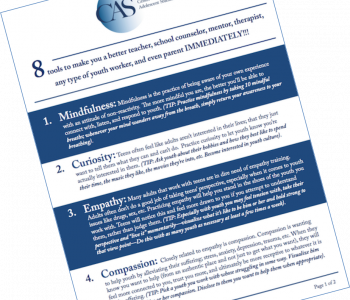

Sam Himelstein, PhD
Sam Himelstein is the founder and CEO of the Center for Adolescent Studies, Inc. He is passionate about working with youth and training the professionals that serve them.
6 Ways to Check-In with Teens
Group work with teens can be both challenging and extremely rewarding. One of the responsibilities we as facilitators are charged with is mixing up content to curtail boredom—the feeling in youth that can easily snowball into disengagement, detachment, and less buy-in. When facilitating group work, whether it’s therapy-based, skills-based, or even a traditional classroom (yes that’s still a group!), one of the most common activities used to gage youths’ current state of mind is a check-in. A check-in where a teen can speak about how they’re feeling, how their day or week’s been, or answer a targeted question related to a discussion or topic that might be presented in the session at some point.
What’s important to know is that there are many different types of check-ins. Ultimately, it’s good to diversify check-ins to be able to give youth more tools to verbalize their experience. The better youth are able to verbalize their experience, the better they’ll be at managing their experience. This is something that we as therapists, counseling, educators, and anyone in the youth field should want to foster. Below are 6 simple but effective methods for integrating a check-in into your group or classroom.
The Mindful Check-In
I have written about the mindful check-in extensively: initially in my first book, A Mindfulness-Based Approach to Working with High-Risk Adolescents and more recently in Mindfulness-Based Substance Abuse Treatment for Adolescents: A 12-Session Curriculum where the mindful check-in is formally integrated into the MBSAT curriculum.
Basically, this involves the teen first taking a breath and collecting their thoughts prior to actually speaking. This gives them a moment to contemplate how they really feel, and then when ready, sharing with the group how they feel in the present moment. They might share an emotion (e.g., happy, sad), a physical feeling (e.g., I’m really tired right now), or even a mental experience (e.g., overwhelmed with thoughts). The key is that they first breathe and then check in about how they’re feeling in the present moment. I encourage youth to avoid general adjectives like “cool” “fine” “good” “okay” “alright” because they’re often used so much in everyday conversation when referring to psychological states that they lose meaning and don’t necessarily describe how someone is actually feeling. This is a good method for any of the check-ins listed in this post. If it’s the first time doing this form of check-in with a group, I instruct participants in taking the breath and then explain, after everyone has checked-in, that we’ll discuss more in depth, the purpose of taking breaths. This is a great way to foster mindfulness without meditating or even saying the word meditation. If you have the group do a check-in like this for a number of sessions, you’ll start to see youth take the breath without you instructing that particular part of the process. And that’s the goal: youth actually picking up a skill that they can take with them moving forward in life. Any check-in below can also (and I’d encourage you to do this) become a mindful check-in by instructing the group to take a breath, collect their thoughts, and focus on how they’re feeling in the present moment prior to actually checking in.
The Numerical Check-In
The numerical check-in is the standard, “On a scale of 1-10, 1 being really negative and 10 being extremely positive, how do you feel right now?” This is actually my least favorite check-in because I believe it feeds into the societal obsession with numbers and statistics and leaves us with little information into what the youth is actually experiencing. Nevertheless, I have personally witnessed its value time and again because many youth I work with naturally express themselves this way. It’s not uncommon for me to be in an informal conversation with a youth where he or she may respond to my question of “how are you feeling right now?” with “like a 7. Could be better, could be worse” without me ever asking them to quantify their experience. This is a simple and effective way for youth to check-in, especially if they don’t have a large vocabulary for emotions or if you have a large group and little time.
The Open Check-In
The open check-in is the least restrictive check-in and gives teens the most flexibility in how they want to check-in. They could talk about how they’re feeling, a past experience, something they’re hoping for, usually for a flexible amount of time. You might simply ask students to check-in and see where they take it. The strength of this type of check-in is that it facilitates self-disclosure among the group, which ultimately will lead to (and be a measuring stick of) the cohesiveness and depth of the group. However, something to be aware of with this check-in is time. Without specific time limits youth could go on and next thing you know you have no time for your curriculum topic or not everyone in the group gets to check it. When deciding to do this type of check-in, make sure to think of class/group size, amount of total time you have, and other curricula you may need to get to during the session.
The One or Two Word Check-In
Conversely to the open check-in, the one or two word check-in is an activity that facilitates a youth to fully own how they’re feeling without extra conversational qualifiers. They must bring their awareness to their primary experience and summarize it with one or two words, which help youth commit their awareness to their present moment experience. The one or two word check-in is also great if you’re limited on time or have a large classroom. Again, be aware of and preempt youth to not use non-descriptive, everyday adjectives like “good” “cool” “fine” “okay” or “alright.” The risk for this check-in is that it limits disclosure and shouldn’t be used too often or your check-ins will become predictable and could facilitate boredom.
The Deep Check-In
The deep check-in is a great way to facilitate empathy, compassion, and deepen group cohesion and trust. This type of check-in shouldn’t be introduced prematurely in a group/class because most youth won’t feel comfortable sharing about themselves if they aren’t yet comfortable with the other group members. Thus, trust-building exercises should be facilitated and the deep check-in should only be used when the facilitator/teacher feels the group is at a level of cohesiveness that can handle deep disclosure and being vulnerable. A deep check-in can be facilitated by asking youth to begin with the statement, “something I’ve been holding in is…” or “something nobody knows about me is…” or “if you really knew me, you’d know…” and then complete the sentence. These have been time tested ways to bring youth into a deeper space with each other and have been used by organizations such as Challenge Day, the Mind Body Awareness Project, the MBSAT program referenced above, the Making the Peace Curriculum (where most of these exercises originated), and probably countless others. What’s important is to have faith that youth can do these exercises so you’ll actually try it with them, while at the same time not forcing this exercise prematurely. Also, as the facilitator of this exercise, it’s important to understand the role and limits of your personal self-disclosure during a deep check-in and how that influences the disclosure of the rest of the group.
The Metaphorical Check-In
Finally, the metaphorical check-in uses metaphor to help youth describe their internal experience. This is a great way to diversify the check-in and tap in to young people’s creativity. Below are 3 of my favorite metaphorical check-ins:
Internal Weather Report: Tell the youth that their feelings are like the weather. They can feel like there’s a sunny day inside (e.g., happy, joy), like it’s gloomy and grey (e.g., bored, down), rainy (e.g., sad, depressed), stormy (e.g., irritated, angry, etc.), or anything else they can think of. Present the metaphor and ask them to give the group their internal weather report. Let them define the weather and its connected emotions however they want.
Movie Genre: The movie genre metaphor is that feelings and experiences are like movie genres (e.g., action, adventure, horror, drama, etc.). Ask the youth to describe the current movie genre that is most salient in their experience. This check-in can also be altered to capture their broader life experience, for example: “What’s been the major movie genre of your life thus far?” And a follow-up question could always be asked, “What one movie best describes your life?” for youth who are really into the metaphor.
Current Playlist: This music metaphor, similar to the movie genre, analogizes music to internal feelings. You might ask, “What instrument is currently playing inside right now?” or “What music or song best represents your feeling right now?” or “If your mood could be represented by music right now, what would it be?” This is a great way to get youth to describe how they’re feeling, especially those that are musically inclined. Encourage flexibility by letting youth answer in their way; whether they speak about an instrument, particular song, album, or musician.
—
The above check-ins represents six different modalities for talking about internal experience. They can be modified in multiple ways to include questions of the day and other important information you might want to draw out of youth in your class or group. The key is to not overuse any one type of check-in. Diversify your check-ins so that youth learn more ways to talk about their internal experience. The more tools they have to be aware of and speak about their experience, the better they’ll manage their experience, which will lead to better overall emotional well-being.
Related posts:
3 Ways Compassion Can Help Youth Impacted by Trauma
3Ways to Make Sure You’re in the Appropriate Teaching Role
4 Different Approaches to Leading Groups of Youth
4 Qualities That Lead to Interpersonal Connection and Safety with Youth
Looking for a practice community that you can check-in with regularly yourself? We want to leverage the power of community through our FREE Resilience Training Community and build on the knowledge of experience of like-minded professionals all over the world. We offer live weekly and monthly practice opportunities and FREE self-paced courses on trauma-informed care, building authentic relationships, teaching mindfulness to teens, and of course, self-care and resilience for yourself! Join now.

